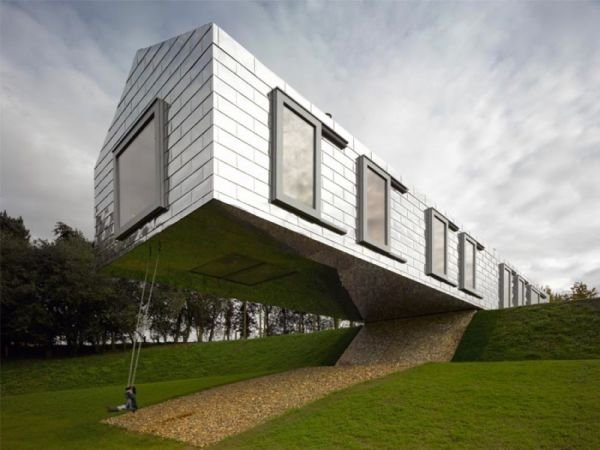This post will conclude the theme of the last few weeks - energy efficiency and its relationship to environmentalism - by examining the kind of ‘green’ building regulations discussed two weeks ago in light of the concepts introduced last week, and considering their implications on the possibility of ‘green’ building, and on the very concept of the home itself.
As noted last week in relation to automobiles, the Jevons paradox makes clear that any savings made through improved efficiencies, whether that be in energy, material, or space, will be eaten elsewhere; and this is no less true of building than of any other field. Say, for example, you make a more efficient hot water unit: where do the energy savings go? At the household level, the savings may be negated by the occupants, who introduce more energy-consuming devices into their home on the grounds that ‘we can afford it now’. If not, the energy they save will be taken up by others in the context of an increasing population; this is especially true of present-day Australia. Economically speaking, the money they save will either be spent, which is just transferring the consumption elsewhere, or perhaps deposited in an interest-bearing bank account, i.e. lent out by the bank to others, which furthers economic growth, which is also consumption.
Say you change your planning codes to allow, encourage, or mandate smaller, more space-efficient houses on smaller blocks. Is less agricultural land devoured? No: there are simply more people on more blocks on the same amount of land. Say you opt for ‘building upwards’ instead, and put everyone in apartment towers: does the required number of refrigerators, televisions, and washing machines decrease? No: it increases with the increasing number of households, even though each household is now living more ‘efficiently’.
Say you make a more efficient screen or monitor, so that each individual screen uses both less space and less energy (this is exactly what happened in the transition from bulky, power-hungry cathode ray tube screens to flat, energy-efficient plasma and LED screens); does the number of screens per household remain the same? No: instead of one or two screens per household in the 1980s, today there might be dozens.
The above examples reveal the problems and contradictions inherent in goals like ‘energy efficiency’ and ‘green consumption’. Consumption simply shifts to other people or other resources, and worms its way into ever smaller niches and cracks. But what are the implications of all this on the idea of home, in a metaphysical sense, particularly in light of concepts such as Ellul’s technique?
The idea of home is being assailed on two fronts: the regulatory and the material. It is difficult to find the right word to characterise this: the home has been pulverised, powderised, atomised, pinched, dismembered, quantified, disenchanted, bureacratised.
On the regulatory front, there might be no better example of the effect of technique than on that icon and image of the traditional home, the open fire. Once innocent, wholesome, poetic, mythic, a symbol of warmth and welcome, the hearth and heart of the home, the open fire has now been deemed by rational analysis to be, unacceptable, unsatisfactory, inefficient, environmentally unfriendly; its measure has been taken, it must be regulated out of existence.
On the material front, the totalising reach of technique can be seen in the change in timber products over the years. From building with whole logs, to large-section post-and-beam, to 2x4 stud wall framing with hardwood, to the same with softwood, to plywood, then OSB, then MDF, which is the literal powderisation of material: buildings made of sweepings and sawdust. MDF is less wasteful, more efficient, you might say. But none of these timber technologies have slowed deforestation in Australia or anywhere else, let alone reversed it.
The tendency of hyper-rational systems of technique to result in hyper-irrational outcomes is evident in the fact that today you can knock down a perfectly serviceable and sound 150m² brick home from the 1950s, a home that has paid its debt in material and energy terms many times over, and erect in its place a 500m² house with a three car garage, the whole suite of integrated ‘smart tech’ controls, solar panels and batteries, floor-to-ceiling triple-glazed argon-filled windows, and an air conditioner in every room, and as long as it achieves a six (now seven) star energy efficiency rating, it can officially be considered ‘green’. We might be aghast at the ‘waste’ involved in building the kind of primitive huts that were once common in Australia, with their large-section, old-growth hardwood timbers. In truth, the lifetime ‘footprint’ of such a structure would be vastly smaller than any passive or ten-star house. Yet you are not allowed to build and live in such a hut today, because the regulations don’t allow it.
In the 1970s you could obtain a building permit with a single sheet of drawings; today the volume and detail of the regulations and the resultant documentation required of architects and building designers is large and only increasing. The regulatory burden never shrinks but always moves towards growth and complexification, because regulatory bureaucracies (which, as you will recall, form a core part of the network of technique) will always act to increase and protect themselves, until, as Joseph Tainter points out, they eventually fall over. I don’t deny that the motivations behind building regulations are benign: the desire to make buildings safer, healthier, more amenable, less wasteful, is to be applauded. But at the same time the negative effects and deeper implications of this trajectory must also be acknowledged.
So if energy-efficiency regulations don’t in fact protect the environment but instead result in an increase in consumption, what is their point? Here is a challenging proposition: on the principal that ‘the purpose of a system is its outcome,’ this is the point, however unspoken, of such regulations. Not to ‘save the planet,’ but to allow us to continue to live in the manner to which we have become accustomed. The wind turbine and the solar panel are not avatars of environmentalism, they are avatars of consumption; efficiency regulations exist not to reduce consumption, but to make consumption more efficient, which is to say, to encourage it.
























































































